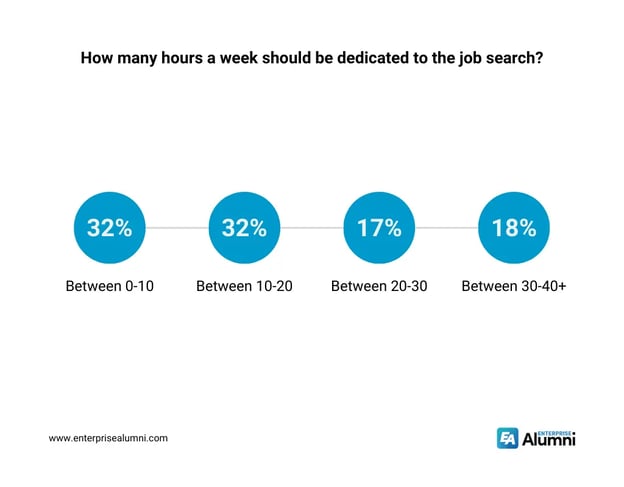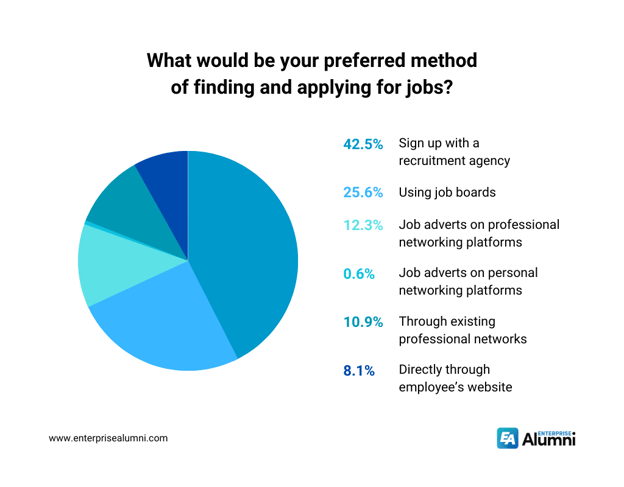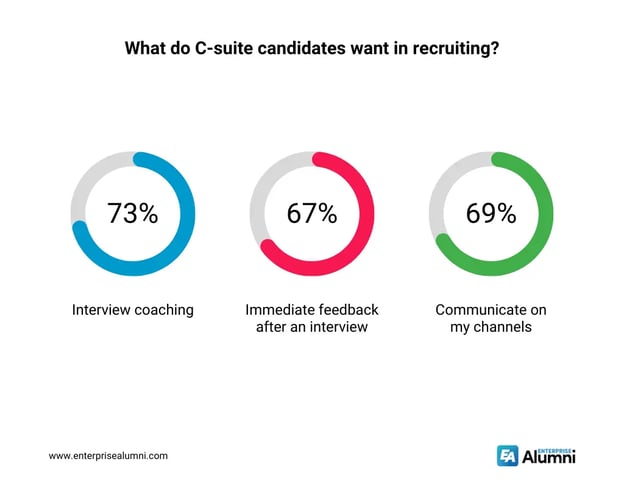
The Future of Talent Acquisition: Key Recruitment Statistics for 2025
Among the factors determining a company's success, the role of people remains the highest. But hiring practices have changed. Here's some reasons how.
Among the factors determining a company's success, the role of people remains the highest. They bring creativity, domain knowledge and diverse skills to the workplace, helping businesses achieve goals, drive motivation and stay competitive in today's fast-paced market.
But, over the last few years, employee needs have changed; people want more than a warm-fuzzy feeling and a good paycheck to stay in a company. As a result, hiring practices have been changed.
Wouldn't it be helpful if you knew the latest hiring trends, like how much time would it take to fill a role? What recruitment channels do employers rely on? What are job searchers' top priorities in the workplace?
You’re in luck. Whether you are a recruiter or a job seeker, we have compiled the best talent acquisition statistics to help you understand the latest hiring trends in minutes.
Key statistics
- Only 62% of workers are satisfied with their job, and 43% of them, despite being satisfied, are looking for new job opportunities. (28)
- On average, recruiters receive 250 applications for a role. (29)
- 79.6% of applicants use LinkedIn to research their interviewers before a job interview. (30)
- Regarding candidate preferences, 42.5% of job seekers register with a recruitment agency, followed by job boards (25.6%) and LinkedIn (12.3%). (30)
- 63% of recruiters prefer resumes to be tailor-made to the job opening. (31)
- 87% of active and passive candidates are open to new job opportunities. (32)
- According to Appcast, 92% of candidates never finish their job applications because of too many steps. (33)
- Candidates should spend at least 25 hours per week searching for work. (34)
- According to research, C-suite candidates expect interview coaching (73%), immediate feedback (67%), and communication on all channels (69%) from employers during the recruitment process. (35)
- People are 4x more likely to consider a company for future opportunities if you offer them constructive feedback. (32)
General Hiring and Recruitment Statistics
The job market has witnessed a significant change in applicant behavior and needs in the last few years. As a result, the current hiring statistics indicate a dramatic industry revolution to help businesses align with such developments.
1. The top recruiting priorities of companies in 2021-
- Improving the quality of hire (52%)
- Increasing retention rate (24%)
- Improving time-to-hire (23%)
- Growing talent pipeline (22%)
- Diversity hiring (22%) (1)
2. In 2020, a majority (66%) of staffing and recruitment professionals saw globalization as a chance for growth and development. (2)
3. 87% of active and passive candidates are open to new job opportunities. (32)
4. 80% of the top 100 highest-earning recruitment agencies operating in more than one country indicate a significant industry globalization trend. (2)
5. According to Bullhorn, 66% of hiring agencies reported a shortage of skilled candidates in 2023, which continued from the years 2021 and 2022. (3)
6. Only 62% of workers are satisfied with their job, and 43% of them, despite being satisfied, are looking for new job opportunities. (28)
7. An overwhelming majority of recruiters (87%) believe possessing a four-year college degree gives an entry-level candidate a competitive edge. (4)
8. A study reveals that 56% of American businesses intend to provide signing bonuses to new hires who have graduated from business schools. (5)
9. 75% of job seekers consider an employer's brand before applying. (6)
10. 100% of Chinese companies and 87% of American employers are using artificial intelligence in some capacity for their hiring processes. (7)
11. Nearly half, or 44%, of organizations utilize publicly accessible information such as social media profiles to accelerate their recruitment procedures. (7)
Resume statistics
Resumes might sound like a thing of the past because of LinkedIn and advanced job tracking applications, but it still plays a major role in hiring. To increase your chances of getting selected for your dream job, check out these latest resume statistics now!
12. 77% of employers believe soft skills are just as important as hard skills. The top ten soft skills that companies look for when hiring candidates are:
- The candidate has a strong work ethic – 73 percent
- The candidate is dependable – 73 percent
- The candidate has a positive attitude – 72 percent
- The candidate is self-motivated – 66 percent
- The candidate is team-oriented – 60 percent
- The candidate is organized and can manage multiple priorities – 57 percent
- The candidate works well under pressure – 57 percent
- The candidate is an effective communicator – 56 percent
- The candidate is flexible – 51 percent
- The candidate is confident – 46 percent (8)
13. 80% of Men and millennials/Gen Z will quit if their employers don't offer requisite training. (9)
14. On average, recruiters receive 250 applications for a role. (29)
15. According to Appcast, 92% of candidates never finish their job applications because of too many steps. (33)
16. Job seekers have just 7.4 seconds to make an impression (10)
17. Half of the companies have observed a rise in the count of applicants holding a master's degree applying for entry-level job positions. (4)
18. 63% of recruiters prefer resumes to be tailor-made to the job opening. (31)
19. Just 24% of graduating college seniors will earn a degree in STEM. (4)
20. The three key trends where most job seekers are making mistakes related to grammar, spelling errors, style, and missing information include-
- 68.7 percent of errors were found in missing accomplishments
- 71.6 percent in miscommunication of skills
- 80.4 percent of resumes had errors in former job experience descriptions.
Job search statistics
Searching for a job can be one of the most frustrating, challenging things you will experience. But knowing the latest trends can help make that process easier. These job search statistics will show you how the hiring landscape has changed and how you can overcome it.
21. The current unemployment rate in the U.S. is 3.4%, with 5.7 million people looking for jobs. (11)
22. In April 2023, the number of unemployed individuals for less than five weeks witnessed a decline of 406,000, settling at 1.9 million. (11)
23. The number of long-term unemployed, those without a job for 27 weeks or more, remained relatively stable at 1.2 million and constituted 20.6% of the overall unemployed population. (11)
24. The latest ZipRecruiter survey found that 90% of recently hired candidates reported hearing back within a week of applying for their job. (12)
25. 79.6% of applicants use LinkedIn to research their interviewers before a job interview. (30)

26. When it comes to job searching, professional networks are the preferred choice for both job seekers (77%) and employers (51%) compared to other social media platforms. (30)
27. LinkedIn is especially popular, with over 90% of job seekers open to job offers through the site and over 80% willing to apply for relevant job openings in their profile feed. (30)
28. As of March 2023, the United States had 9.6 million available job positions, and 6.1 million individuals had been hired to fill those positions. (13)
29. 72% of employers are having a hard time finding skilled candidates (14)
30. Candidates should spend at least 25 hours per week searching for work. (34)
31. Businesses can 10 times their talent pool by recruiting through employee networks. (15)
32. When it comes to candidate preferences, 42.5% of job seekers register with a recruitment agency, followed by job boards (25.6%) and LinkedIn (12.3%). (30)
33. Most people discover new jobs through referrals. (16)
Job interview statistics
Job interviews can be a stressful experience for both candidates and employers, especially with increasing resignation rates and new job trends. Providing the best interview experience has become critical for employers, while job seekers are eager to learn how to ace their interviews and land their dream jobs.
34. In the United States, the typical duration of the interview process is 23.8 days. Brazil job seekers reported the longest average interview process of 39.6 days, whereas India reported the lowest (16.1 days).
35. According to the CareerBuilder survey on social media recruitment conducted annually, 35% of employers are less inclined to interview candidates who do not have an online presence. (18)
36. Investing in advanced interviewing techniques is identified as a major trend for the immediate future by 34% of recruiters. (19)
37. People are 4x more likely to consider a company for future opportunities if you offer them constructive feedback. (32)
38. Structured interviews are the most common interviewing method and are employed by 74% of H.R. professionals, followed by behavioral interviews (73%), phone screening (57%), and panel interviews (48%). (20)
39. While a simple job interview may appear attractive to candidates, research by Glassdoor has shown that increasing the difficulty of the interview by 10% results in a 2.6% increase in the satisfaction of the newly hired employee. This outcome is not unexpected, as we typically attach more significance to things we put more effort into. (21)
40. Businesses that invest in building a robust recruitment process witnessed a 70% enhancement in the caliber of their hires. (21)
41. According to research, C-suite candidates expect interview coaching (73%), immediate feedback (67%), and communication on all channels (69%) from employers during the recruitment process. (35)
Gen Z & Millennials Recruitment Statistics
Gen Z and Millennials make up a significant percentage of the workforce, and there are certain things that hiring managers should know. These recruitment statistics will help employers understand what these people are looking for and how they can work to hire great talent.
42. Organizational culture is highly valued by 65% of millennials, a proportion that surpasses that of baby boomers and Generation X. (22)
43. The Generation Z workforce is most content in job positions that allow them to influence the company culture and make a social impact, with the most highly rated roles being corporate recruiter (ranked #1 with a score of 4.79 out of 5), marketing manager (#2, 4.56), and social media manager (#3, 4.46). (23)
44. It is crucial to focus on this age group because they constitute the largest segment of the U.S. workforce. Millennials account for over a third of all employees (35%). (24)
45. According to a survey, 83% of Millennials and 80% of Gen Z feel that business success should encompass more than just generating profits. Along with diversity, they believe that companies should positively influence society, create innovative products or services, and prioritize career growth. (25)
46. According to the Glassdoor study, 90% of Millennials prefer benefits over a salary increase. Additionally, research has demonstrated that Millennials are not solely motivated by money.
47. A survey found that mental health is significant for 82% of Generation Z workers who value taking mental health days, while 50% of them are interested in receiving mental health training. (27)
48. According to a survey, 77% of respondents believe working for an organization that prioritizes diversity, equity, and inclusion is important. (27)
Wrapping Up
That's it. These were some of the top talent acquisition statistics that could benefit the employer and the candidates. Recruitment today is complicated; you cannot start hiring without understanding the trends.
If you want to learn about corporate alumni networks and how to use them to hire talents, drive productivity and reduce costs, then you should check out EnterpriseAlumni.
Resources
-
Revealed: Five recruitment priorities for 2021 (HRD)
-
What Does Globalization Mean for the Staffing Industry? (Bullhorn)
-
GRID 2023 Industry Trends Report (Bullhorn)
- iCIMS 2023 Workforce Report (iCIMS)
-
Corporate Recruiters Survey Report 2018 (Gmac)
-
Employer Brand Statistics (LinkedIn)
-
Employers Embrace Artificial Intelligence for HR (SHRM)
-
Overwhelming Majority of Companies Say Soft Skills Are Just as Important as Hard Skills, According to a New CareerBuilder Survey (CareerBuilder)
-
New Global Udemy Report Finds Workers Increasingly Aware of the Skills Gap, Yet Optimistic about the Future (Udemy)
-
You have 7.4 seconds to make an impression: How recruiters see your resume. (Ladders)
-
Economic News Release (US Bureau of Labor Statistics)
-
Survey of Recently Hired Workers (Ziprecruiter)
-
Job openings and labor turnover – March 2023 (BLS)
-
The talent shortage (ManpowerGroup)
-
Top 100 Hiring Statistics for 2022 (Linkedln)
-
Introducing the New LinkedIn Referral Experience: Making It Easier to Find Your Way In (Linkedln)
-
How Long Does it Take to Hire? Interview Duration in 25 Countries (Glassdoor)
-
35 percent of employers less likely to interview applicants they can't find online, according to annual CareerBuilder social media recruitment survey (CareerBuilder)
-
Global Recruiting Trends for 2017 (Linkedln)
-
Global Recruiting Trends 2018 (Linkedln)
-
Do Difficult Job Interviews Lead to More Satisfied Workers? Evidence from Glassdoor Reviews (Glassdoor)
-
Employee Benefits: What Each Generation Wants (Glassdoor)
-
A Change of Pace For Gen Z Employees Entering the Workforce (Glassdoor)
-
Millennials are the largest generation in the U.S. labor force (Pew Research Center)
-
2018 Global Human Capital Trends (Deloitte)
-
5 Awesome Job Benefits That Attract Quality Candidates (Glassdoor)
-
Gen Z in the Workplace (TalentIMS)
-
2022 Job Seeker Nation Report (Jobvite)
-
50 HR & Recruiting Stats That Make You Think (Glassdoor)
-
Using social media in the recruitment process (Insight)
-
Matching your resume to the job you want (CareerBuilder)
-
The Ultimate List of Hiring Statistics (Linkedln)
-
Most People—92%—Never Finish Online Job Applications (SHRM)
-
𝗛𝗼𝘄 𝗠𝗮𝗻𝘆 𝗛𝗼𝘂𝗿𝘀 𝗮 𝗪𝗲𝗲𝗸 𝗦𝗵𝗼𝘂𝗹𝗱 𝗢𝗻𝗲 𝗗𝗲𝗱𝗶𝗰𝗮𝘁𝗲 𝘁𝗼 𝗧𝗵𝗲𝗶𝗿 𝗝𝗼𝗯 𝗦𝗲𝗮𝗿𝗰𝗵 (Linkedln)
-
The future of recruiting (PWC)

